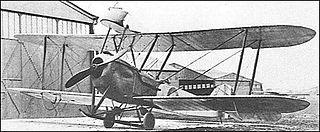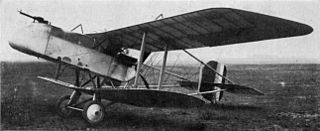Related Research Articles

The Sopwith Triplane was a British single seat fighter aircraft designed and manufactured by the Sopwith Aviation Company during the First World War. It was the first military triplane to see operational service. The Triplane joined Royal Naval Air Service squadrons in early 1917 and was immediately successful. It was nevertheless built in comparatively small numbers and was withdrawn from active service as Sopwith Camels arrived in the latter half of 1917. Surviving Triplanes continued to serve as operational trainers until the end of the war.

The Airco DH.2 was a single-seat biplane "pusher" aircraft which operated as a fighter during the First World War. It was the second pusher design by aeronautical engineer Geoffrey de Havilland for Airco, based on his earlier DH.1 two-seater.

Between 1911 and 1914, the Royal Aircraft Factory used the F.E.2 designation for three quite different aircraft that shared only a common "Farman" pusher biplane layout.

The Sopwith 1 1⁄2 Strutter was a British single- or two-seat multi-role biplane aircraft of the First World War. It was significant as the first British two-seat tractor fighter and the first British aircraft to enter service with a synchronised machine gun. It was given the name 1 1⁄2 Strutter because of the long and short cabane struts that supported the top wing. The type was operated by both British air services and was in widespread but lacklustre service with the French Aéronautique Militaire.
The Boulton & Paul P.3 Bobolink was a World War I British single-engined single-seat fighter aircraft. It was built by Boulton & Paul Ltd.

The Foster mounting was a device fitted to some fighter aircraft of the Royal Flying Corps during the First World War. It was designed to enable a machine gun to fire over, rather than through the arc of the spinning propeller. It took several forms when applied to different aircraft types, but all shared the feature of a quadrant shaped I-beam rail on which the gun could slide back and down in one movement. The primary purpose was to facilitate the changing of spent ammunition drums, but some pilots also found that the mounting permitted the gun to be fired directly upward or at an angle, permitting a fighter aircraft to attack an opponent from beneath.

The Armstrong Whitworth F.K.10 was a British two-seat quadruplane fighter aircraft built by Armstrong Whitworth during the First World War. While it was ordered in small numbers for the Royal Flying Corps and Royal Naval Air Service, it was not used operationally. It is one of the few quadruplane aircraft to reach production.

The Vickers F.B.26 Vampire was a British single-seat pusher biplane fighter built by Vickers during the First World War.
The Armstrong Whitworth Armadillo was a British single-seat biplane fighter aircraft built by Armstrong Whitworth.

The Austin A.F.T.3 Osprey was a prototype British fighter triplane of the First World War. Developed by the motor car manufacturer Austin as a replacement to the Sopwith Camel, only one was built, the Sopwith Snipe being preferred.
The Sopwith 2FR.2 Bulldog was a prototype British two-seat fighter of the First World War. A single-engined biplane, the Bulldog was a fighter/reconnaissance aircraft intended to replace the Bristol F.2 Fighter, but was unsuccessful, with no replacement for the Bristol Fighter being purchased.
The Sage Type 2 was a prototype British two-seat fighter aircraft of the First World War. A single-engined biplane with an enclosed cabin for its crew, only a single example was built, as more advanced aircraft became available.
The Armstrong Whitworth F.K.5 and F.K.6 were experimental triplanes built as escort fighters by Armstrong Whitworth during the First World War. They carried two gunners in nacelles mounted on the centre wing. One example of each type was built, with no further development or production following.

The Vickers F.B.11 was a prototype British three-seat escort fighter of the First World War. A large single-engined biplane, it carried one gunner in a nacelle mounted on the upper wing to give an allround field of fire. Only a single example was completed.
The Sopwith Gunbus was a British fighter aircraft of the First World War. It was a single-engined pusher biplane based on a floatplane built by Sopwith before the war for Greece. Small numbers were built and used by the British Royal Naval Air Service, mainly as a trainer.

The Royal Aircraft Factory F.E.9 was a prototype British two-seat fighter-reconnaissance aircraft of the First World War. A single-engined pusher biplane of 1917, the F.E.9 had poor performance and handling, and only three were built.

The Royal Aircraft Factory N.E.1 was a prototype British Night fighter of the First World War. A single-engined pusher biplane, it was a development of the Royal Aircraft Factory's earlier F.E.9 fighter, but was not successful, only six being built.
The Royal Aircraft Factory A.E.3, also known as the Farnborough Ram, was a prototype British armoured ground attack aircraft of the First World War. The A.E.3, which was a development of the Royal Aircraft Factory's N.E.1 night fighter, was a two-seat single-engined pusher biplane. Three were built in 1918, but the type was unsuccessful, with no further production ensuing.
The Sopwith Snark was a British prototype fighter aircraft designed and built towards the end of the First World War to replace the RAF's Sopwith Snipes. A single engined triplane, the Snark did not fly until after the end of the war, only three being built.
The Sopwith 3F.2 Hippo was a prototype British two-seat fighter aircraft of the First World War. It was a single-engined biplane with considerable negative stagger. It was not successful, the Bristol F.2 Fighter being preferred by the Royal Flying Corps.
References
- Bruce, J. M. British Aeroplanes 1914-18. London: Putnam, 1957.
- Bruce, J. M. War Planes of the First World War: Volume Two Fighters. London: Macdonald, 1968. ISBN 0-356-01473-8.
- Green, William, and Swanborough, Gordon. The Complete Book of Fighters. New York: Smithmark, 1994. ISBN 0-8317-3939-8.
- Lewis, Peter. The British Fighter since 1912. London: Putnam, Fourth edition, 1979. ISBN 0-370-10049-2.
- Mason, Francis K. The British Fighter since 1912. Annapolis, Maryland, USA: Naval Institute Press, 1992. ISBN 1-55750-082-7.